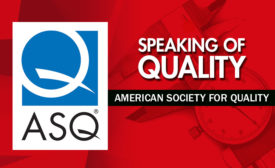Home » American Society for Quality (ASQ)
Articles Tagged with ''American Society for Quality (ASQ)''
Lean and agile can work alone but can be very powerful together.
Read More
ASQ Guest Column
The Gift of Recognition
It is truly priceless to see and hear people’s appreciation.
April 8, 2019
In Search of Precision Measurements
This is a new experience for many students.
March 15, 2019
A New Year, A Solid Career
As you examine your future in quality, keep these items in mind.
January 15, 2019
Policies Drive Quality Procedures
Understanding the use and limits of both goes a long way.
December 15, 2018
Quality Management System: Bureaucracy or Key Success Factor?
When implementing a QMS, make sure you include the following.
November 15, 2018
Industry and Quality 4.0: Bringing Them Together
Both manufacturing and methodology have evolved.
October 8, 2018
An Educational & Scientific Purpose
ASQ continues to connect the global quality community.
October 8, 2018
Stay in the know with Quality’s comprehensive coverage of
the manufacturing and metrology industries.
eNewsletter | Website | eMagazine
JOIN TODAY!Copyright ©2024. All Rights Reserved BNP Media.
Design, CMS, Hosting & Web Development :: ePublishing




